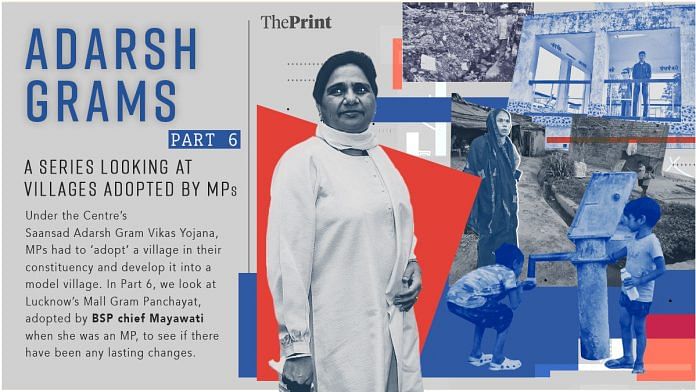Malihabad: Ashutosh Chaurasia was astounded when he learned a few weeks ago that Bahujan Samaj Party chief Mayawati had “adopted” Mall gram panchayat in Lucknow’s Malihabad tehsil a decade ago. As the pradhan of the gram panchayat, which covers five villages, he took it upon himself to go on a fact-finding mission.
“I had to make a few calls to confirm if this was indeed the gram panchayat that was adopted,” he told ThePrint.
Elected pradhan in 2021, four years after Mayawati resigned from the Rajya Sabha, Chaurasia claims the adoption under the central government’s Saansad Adarsh Gram Vikas Yojana (SAGY) scheme had minimal impact. It brought neither significant improvements nor lasting changes.
Under SAGY, launched in 2014 by Prime Minister Narendra Modi, each MP was expected to develop three gram panchayats by March 2019 and an additional five by 2024, using resources pooled from various central and state programmes, including the Member of Parliament Local Area Development Scheme (MPLADS). The objective was to transform each panchayat into a model for others, thus facilitating a virtuous cycle of long-term development and social change.
But at Mall gram panchayat, poor sanitation and a lack of basic infrastructure remain chronic problems. Piles of garbage litter the kuccha village roads while open drains and stagnant water make mosquito infestation a year-round health hazard.
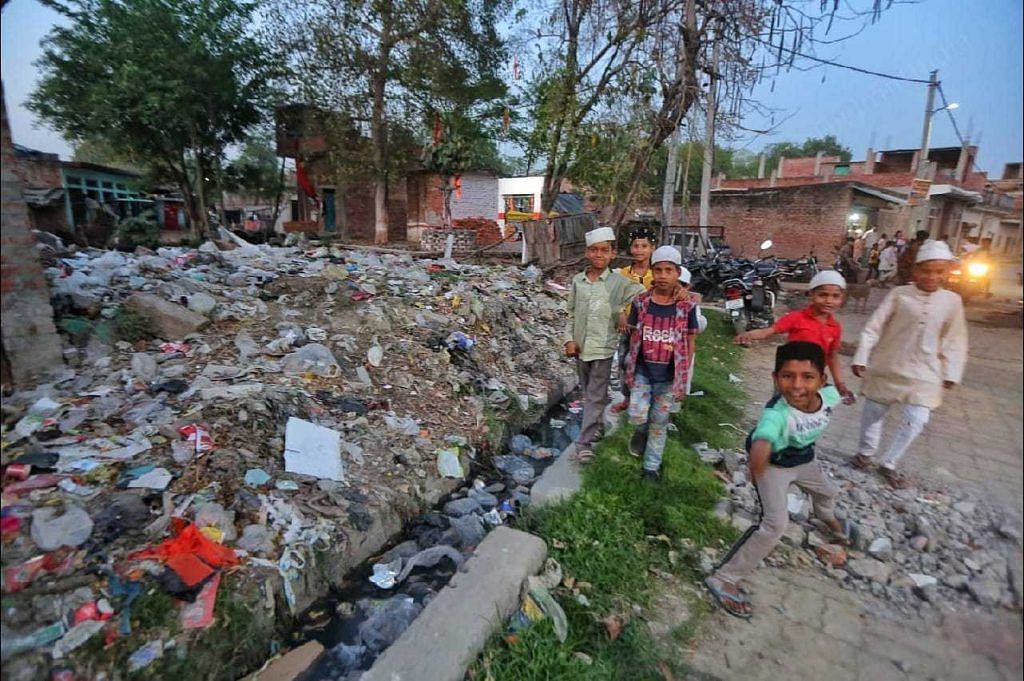
The condition of this gram panchayat also raises questions about the long-term sustainability of SAGY, particularly for villages after their adopting MP quits or their term ends.
In the years between 2014 and 2017, when Mayawati was a Rajya Sabha MP, she directed some of her MPLADS funds to Mall Gram Panchayat, confirmed officials of the District Rural Development Authority in Lucknow.
“Right after the adoption, a road was built in Ambedkar Tola (a predominantly Dalit area) and interlocking work was also done,” said Chaurasia, who also confirmed various changes made by Mayawati with district officials. Other than this, a few village roads were paved, and some electric lines and transformers were installed.
“But since then, no work has been done,” Chaurasia claimed.
Mayawati resigned from the Rajya Sabha in 2017, and is currently not an MP.
The original SAGY guidelines don’t provide for situations where the MP ceases to be a member of Parliament. It also doesn’t specify a course of action if goals under the scheme are not achieved. However, an advisory issued by the Ministry of Rural Development last year offers some clarifications for cases where MPs are unable or unwilling to continue work in a particular gram panchayat.
If work has already begun under a village development plan (VDP), the village remains under SAGY and the state government is obligated to implement it, the advisory says. Ministry sources told ThePrint that this advisory also applies when an MP retires or ceases to be a parliamentarian.
This means that Mall gram panchayat is still technically ‘adopted’ under SAGY, but for villagers this does not mean much. They report that they never experienced any major benefits from the village adoption programme in the first place.
Also Read: ‘Two taps, two lights’— what Raebareli village got out of being adopted by Sonia Gandhi
‘If only Behenji had visited once…’
Tucked away in Malihabad, famous for its fragrant Dasheri mangoes, Mall Gram Panchayat has five villages under it — Bhanwar, Mall, Naru, Vidhishyama, and Gagan Barauli. The gram panchayat has 1,513 households, with 41 percent belonging to the Dalit community, according to a baseline survey conducted under SAGY in 2015.
Under the scheme, gram panchayats are supposed to undergo a flurry of changes through “processes which lead to holistic development”. This includes the MPs themselves “spearheading” the planning stage through “environment creation and social mobilisation” with the help of local governance bodies.
“I was very proud that my village was the only one in the whole of India that Mayawati adopted,” recalled 26-year-old Dinesh Kumar, a resident of Mall village’s Ambedkar Tola who was only 15 when the BSP leader chose the gram panchayat under SAGY.

However, this enthusiasm died down quickly. Villagers claim Mayawati, affectionately called “Behenji,” never visited.
“She took care of the village but couldn’t come down here. Work was done initially but she didn’t come to the village to see it,” said 45-year-old Om Prakash, as he sat with friends in front of a statue of Dalit icon BR Ambedkar in Ambedkar Tola.
A wistful note crept into Om Prakash’s voice. “We just wanted Behenji to visit once. Whichever village she reaches, it almost feels as if it starts raining gold. People run around to get everything done quickly,” he said. “We thought that if Behenji came to the village once, it would’ve lit up entirely.”
Despite some initial improvements like lights and paved lanes, the current reality is far from the “adarsh” envisaged by SAGY. Open sewers, overflowing garbage dumps, and limited livelihood opportunities plague all five villages.
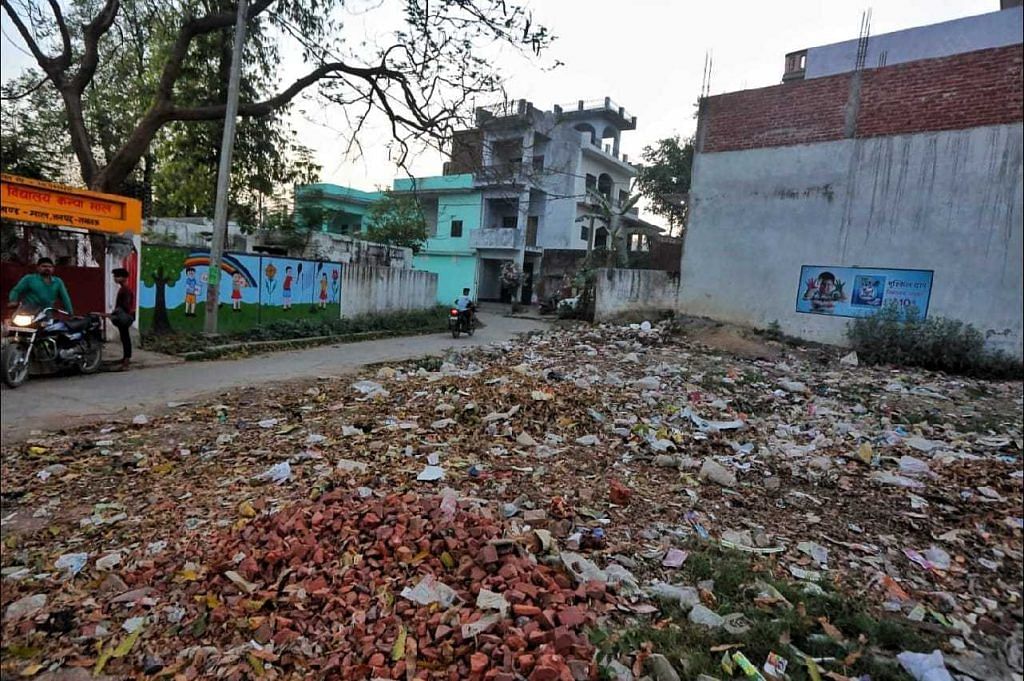
According to an official from the area’s Block Development Office, only about 50 percent of the drains are covered, leaving the villages open to mosquito infestation.
“These sewers breed diseases. No cleaning happens here. And then, if our children get sick, we’ll have to run around to hospitals and dispensaries with them,” said 41-year-old Geeta Devi, who’s been living in Vidhishyama village for 22 years.
Water is another problem, said Chunni Lal, another resident of Ambedkar Tola. He claimed that while the village has a water tank, all houses are not supplied because the pipelines are either incomplete or damaged at several places.
“Whatever work was done back then, that is also falling apart,” Om Prakash said. “Repairs are done, but there has been no new work.”
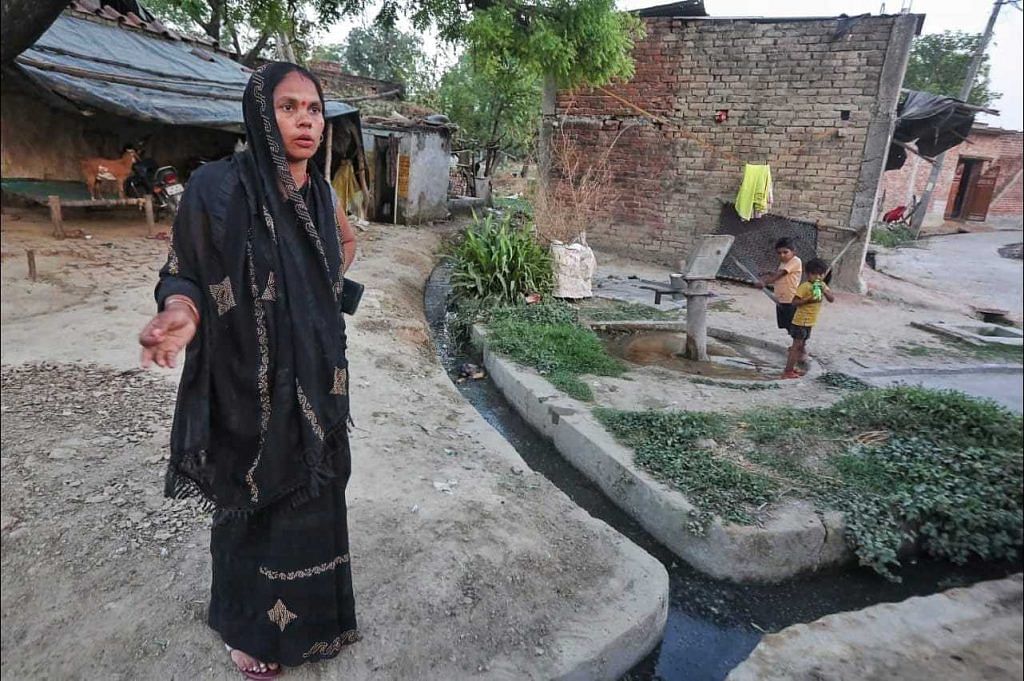
Losing a ‘parent’ MP
In August 2017, nine months before her term as a Rajya Sabha MP was to end, Mayawati resigned from the House, claiming that she was being silenced from speaking out on atrocities against Dalits. Amid this political drama, Mall gram panchayat’s status was left in limbo.
So, what happens to an adopted village that loses its ‘parent’ MP?
To answer this, sources in the Ministry of Rural Development pointed to an advisory issued to all states and Union territories in August last year. It detailed changes an MP can make to the gram panchayat selected under SAGY, including replacing it with another in the same parliamentary constituency or state. The same advisory applies when an MP leaves office, according to ministry sources.

The advisory outlines three scenarios. First, if a village development plan (VDP) hasn’t been prepared or approved, the MP can ask the ministry for a change through the state government, with reasons.
Second, if the VDP has been approved but no projects have started, the state government recommends a course of action to the ministry.
Third, if the VDP has been approved and some work has begun or finished, no change of the status of the gram panchayat is allowed. The state is then advised to complete pending projects or adjust the VDP based on feasibility or legitimate difficulties.
Mall gram panchayat falls into the third category, as a baseline survey was conducted and a VDP was prepared. An undated VDP report, seen by ThePrint, lists all pending development projects—in healthcare, handpump renovation, drainage, solar lighting, and rural electrification—as “completed”.

However, the SAGY guidelines also talk about “post-project sustainability”— indicating that making a village “adarsh” isn’t about a series of one-off measures.
To this end, the document lists five pointers.
First, it says that sustainability will be achieved through “continuing leadership and guidance of the MP”. Second, it holds the gram panchayat and community responsible for “ownership and leadership”, with clear roles assigned for maintaining assets created under the programme. Third, private sector involvement is encouraged for larger assets like sewerage and water supply systems. Fourth, it says self-help groups should help maintain smaller assets like vermicompost systems, nutrition centres, and libraries. And, finally, the guidelines require clear departmental responsibilities to be laid down for operation and maintenance when projects are approved under the VDP.
At the end of the Sustainability chapter is a quote by Swami Vivekananda: “Arise, awake, and stop not till the goal is reached.” However, the guidelines don’t account for villages where goals aren’t achieved and the MP resigns or leaves office.
Also Read: Dalit housing, Ambedkar Gram to UPSC hubs. Are Mayawati’s legacies surviving in UP today?
‘Surviving on quick fixes’
The Saansad Adarsh Gram Vikas Yojana is nothing if not ambitious, listing several lofty goals on its website. These include improving living standards for all sections of the population through better basic amenities, higher productivity, and improved livelihoods. The scheme also aims to create more employment opportunities and reduce distress migration.
However, residents of Mall gram panchayat often struggle to make ends meet. While they are in the heart of Uttar Pradesh’s mango belt, the seasonal nature of cultivation forces them to seek alternative sources of income.
A BDO official noted that the Mall gram panchayat has 756 cardholders under the Mahatma Gandhi National Rural Employment Guarantee Scheme (MGNREGA), a central government programme that guarantees 100 days of wage employment to rural unskilled labourers.
In Malihabad, MGNREGA offered another major income source. Until 2019, people operating small nurseries could sell their plants through the programme. This provision particularly benefitted underprivileged communities, according to Om Prakash.
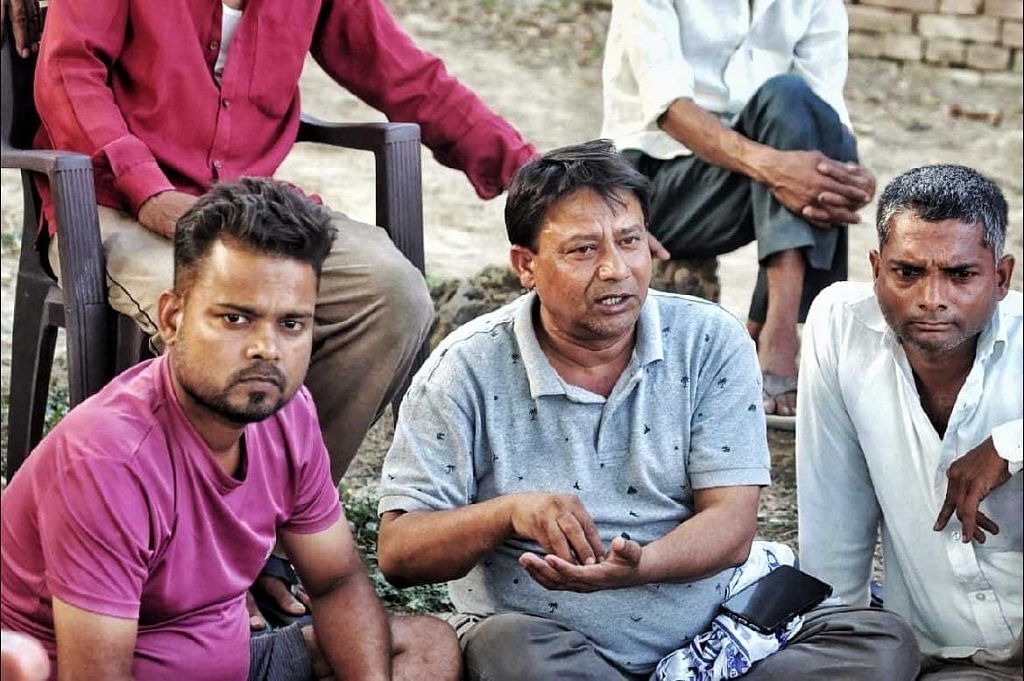
He explained that this was because while the “Suvarna samaj” (higher castes) had large landholdings, most villagers only had small plots in which they grew guavas, mangoes, and other fruits.
But this system faltered after it was mandated that all planting materials under MGNREGA be procured from either government nurseries or government-approved private nurseries. This rule was instated in the 2019-20 annual MGNREGA circular and has been there since. Up until 2018-19, self-help groups or individuals could also take up nursery work under MGNREGA.
“This has led to several village nurseries being rendered redundant,” Om Prakash said.
The lack of employment opportunities has led to people migrating from the village.
“We want businesses and jobs. People here are surviving on jugaad (quick fixes). Don’t give us free foodgrains (under the Pradhan Mantri Garib Kalyan Anna Yojana). We’d rather have employment and better education,” Om Prakash said, as the villagers around him nodded in approval.
Despite this, people in Mall credit Prime Minister Narendra Modi and Uttar Pradesh Chief Minister Yogi Adityanath for some of the progress made in the gram panchayat. One scheme they value is the Jal Jeevan Mission, which aims to provide potable water via household taps.
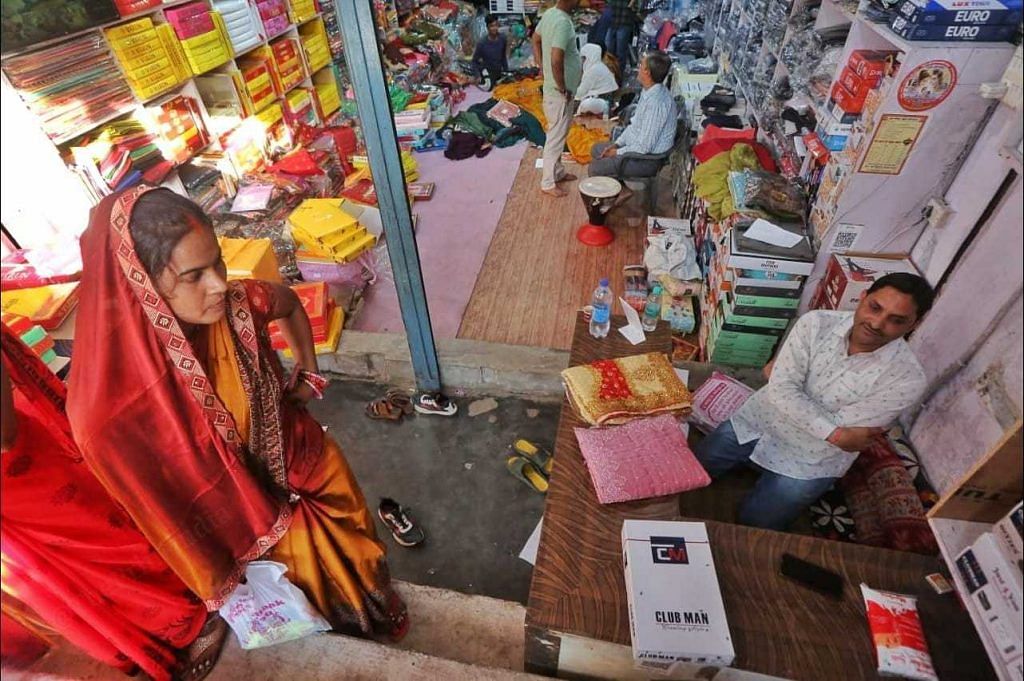
“Under the Jal Jeevan Mission, many people are getting water now. People are benefitting from other (central and state) schemes too,” Chaurasia said. A customer entering Chaurasia’s sari shop chimed in for good measure: “Everybody is happy under Modi’s rule.”
However, at Ambedkar Tola, people hold a more cynical view. While Deven Kumar acknowledges that Mayawati did little for the gram panchayat, he blames its lack of development on the ‘double engine’ BJP governments at the Centre and in the state.
“The power (to do something) lies with CM Yogi,” he said.
But Om Prakash is keeping his expectations low. For him, government schemes exist only on paper, and regardless of who is in power, things rarely change in this corner of the state.
We have seen many governments come and go,” he said. “They do some work, but everyone has their agenda and their axes to grind. The village remains the same.”
Also Read: HPCL to Reliance, Modi’s adarsh villages have hit CSR jackpot — solar lights, roads, anganwadis
(Edited by Uttara Ramaswamy and Asavari Singh)


